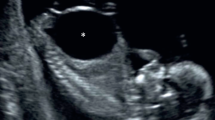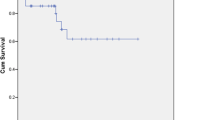Abstract
Objective:
Decision-making for pregnancies complicated by severe congenital anomalies of the kidneys and urinary tract (CAKUT) are ethically challenging, partly because the outcomes are not well studied.
Study design:
Retrospective cohort study of severe cases of CAKUT over 14 years.
Results:
Seventy-one of the 108 cases could be completely analyzed. Forty-six percent (n=33) infants were live-born; one-third (n=11) survived to 12 months. Twice as many non-surviving infants received a trial of therapy vs comfort care only. Two-thirds of non-survivors who received a trial of therapy died within the first 9 h of life. Live-born infants faced morbidities such as pneumothorax and neonatal dialysis.
Conclusions:
Over half of pregnancies complicated by severe CAKUT ended in termination or stillbirth, but one-third of live-born infants survived to 12 months and the majority of non-survivors died within hours. This may allay concerns about prolonged and futile intensive care for parents considering a trial of therapy.
This is a preview of subscription content, access via your institution
Access options
Subscribe to this journal
Receive 12 print issues and online access
$259.00 per year
only $21.58 per issue
Buy this article
- Purchase on Springer Link
- Instant access to full article PDF
Prices may be subject to local taxes which are calculated during checkout


Similar content being viewed by others
References
Carr MC, Kim SS . Prenatal management of urogenital disorders. Urol Clin North Am 2010; 37 (2): 149–158.
Clayton DB, Brock JW 3rd . Prenatal ultrasonography: implications for pediatric urology. J Pediatr Urol 2011; 7 (2): 118–125.
Hogan J, Dourthe ME, Blondiaux E, Jouannic JM, Garel C, Ulinski T . Renal outcome in children with antenatal diagnosis of severe CAKUT. Pediatr Nephrol 2012; 27 (3): 497–502.
Kemper MJ, Mueller-Wiefel DE . Prognosis of antenatally diagnosed oligohydramnios of renal origin. Eur J Pediatr 2007; 166 (5): 393–398.
Kerecuk L, Schreuder MF, Woolf AS . Renal tract malformations: perspectives for nephrologists. Nat Clin Pract Nephrol 2008; 4 (6): 312–325.
Lissauer D, Morris RK, Kilby MD . Fetal lower urinary tract obstruction. Semin Fetal Neonatal Med 2007; 12 (6): 464–470.
Rees L . Paediatrics: infant dialysis—what makes it special? Nat Rev Nephrol 2013; 9 (1): 15–17.
Wiesel A, Queisser-Luft A, Clementi M, Bianca S, Stoll C . Prenatal detection of congenital renal malformations by fetal ultrasonographic examination: an analysis of 709,030 births in 12 European countries. Eur J Med Genet 2005; 48 (2): 131–144.
Lee RS, Cendron M, Kinnamon DD, Nguyen HT . Antenatal hydronephrosis as a predictor of postnatal outcome: a meta-analysis. Pediatrics 2006; 118 (2): 586–593.
Thomas DF . Prenatally diagnosed urinary tract abnormalities: long-term outcome. Semin Fetal Neonatal Med 2008; 13 (3): 189–195.
Woodhouse CR, Neild GH, Yu RN, Bauer S . Adult care of children from pediatric urology. J Urol 2012; 187 (4): 1164–1171.
Carey WA, Martz KL, Warady BA . Outcome of patients initiating chronic peritoneal dialysis during the first year of life. Pediatrics 2015; 136 (3): e615–e622.
Carpenter MW, Corrado F, Sung J . Lethal fetal renal anomalies and obstetric outcome. Eur J Obstet Gynecol Reprod Biol 2000; 89 (2): 149–152.
Damen-Elias HA, De Jong TP, Stigter RH, Visser GH, Stoutenbeek PH . Congenital renal tract anomalies: outcome and follow-up of 402 cases detected antenatally between 1986 and 2001. Ultrasound Obstet Gynecol 2005; 25 (2): 134–143.
Gloor JM, Ogburn PL Jr, Breckle RJ, Morgenstern BZ, Milliner DS . Urinary tract anomalies detected by prenatal ultrasound examination at Mayo Clinic Rochester. Mayo Clinic Proc Mayo Clinic 1995; 70 (6): 526–531.
Grijseels EW, van-Hornstra PT, Govaerts LC, Cohen-Overbeek TE, de Krijger RR, Smit BJ et al. Outcome of pregnancies complicated by oligohydramnios or anhydramnios of renal origin. Prenat Diagn 2011; 31 (11): 1039–1045.
Hsieh MH, Lai J, Saigal CS, Urologic Diseases in America Project. Trends in prenatal sonography use and subsequent urologic diagnoses and abortions in the United States. J Pediatr Urol 2009; 5 (6): 490–494.
Jouannic JM, Hyett JA, Pandya PP, Gulbis B, Rodeck CH, Jauniaux E . Perinatal outcome in fetuses with megacystis in the first half of pregnancy. Prenat Diagn 2003; 23 (4): 340–344.
Klaassen I, Neuhaus TJ, Mueller-Wiefel DE, Kemper MJ . Antenatal oligohydramnios of renal origin: long-term outcome. Nephrol Dial Transplant 2007; 22 (2): 432–439.
Mallik M, Watson AR . Antenatally detected urinary tract abnormalities: more detection but less action. Pediatr Nephrol 2008; 23 (6): 897–904.
Mehler K, Beck BB, Kaul I, Rahimi G, Hoppe B, Kribs A . Respiratory and general outcome in neonates with renal oligohydramnios—a single-centre experience. Nephrol Dial Transplant 2011; 26 (11): 3514–3522.
Melo BF, Aguiar MB, Bouzada MC, Aguiar RL, Pereira AK, Paixao GM et al. Early risk factors for neonatal mortality in CAKUT: analysis of 524 affected newborns. Pediatr Nephrol 2012; 27 (6): 965–972.
Morris RK, Kilby MD . Long-term renal and neurodevelopmental outcome in infants with LUTO, with and without fetal intervention. Early Hum Dev 2011; 87 (9): 607–610.
Podevin G, Mandelbrot L, Vuillard E, Oury JF, Aigrain Y . Outcome of urological abnormalities prenatally diagnosed by ultrasound. Fetal Diagn Ther 1996; 11 (3): 181–190.
Quirino IG, Diniz JS, Bouzada MC, Pereira AK, Lopes TJ, Paixao GM et al. Clinical course of 822 children with prenatally detected nephrouropathies. Clin J Am Soc Nephrol 2012; 7 (3): 444–451.
Spaggiari E, Stirnemann JJ, Heidet L, Dreux S, Ville Y, Oury JF et al. Outcome following prenatal diagnosis of severe bilateral renal hypoplasia. Prenat Diagn 2013; 33 (12): 1167–1172.
Barfield WD, Committee on Fetus and Newborn. Standard terminology for fetal, infant, and perinatal deaths. Pediatrics 2011; 128 (1): 177–181.
Harris PA, Taylor R, Thielke R, Payne J, Gonzalez N, Conde JG . Research electronic data capture (REDCap)—a metadata-driven methodology and workflow process for providing translational research informatics support. J Biomed Inform 2009; 42 (2): 377–381.
Ryckewaert-D'Halluin A, Le Bouar G, Odent S, Milon J, D'Herve D, Lucas J et al. Diagnosis of fetal urinary tract malformations: prenatal management and postnatal outcome. Prenat Diagn 2011; 31 (11): 1013–1020.
Denny E, Quinlan-Jones E, Bibila S, Kilby M . The experience of pregnant women with a diagnosis of fetal lower urinary tract obstruction (LUTO). Midwifery 2013; 30 (6): 636–642.
Lantos JD, Warady BA . The evolving ethics of infant dialysis. Pediatr Nephrol 2013; 28 (10): 1943–1947.
Shooter M, Watson A . The ethics of withholding and withdrawing dialysis therapy in infants. Pediatr Nephrol 2000; 14 (4): 347–351.
Teh JC, Frieling ML, Sienna JL, Geary DF . Attitudes of caregivers to management of end-stage renal disease in infants. Peritoneal Dial Int 2011; 31 (4): 459–465.
Acknowledgements
We thank Dr Marcie Treadwell (Division of Maternal and Fetal Medicine, Department of Obstetrics and Gynecology, University of Michigan), Jeannie Kreutzman, Michigan Institute for Clinical and Health Research grant support (CTSA: UL1TR000433) for REDCap use and Corey Powell at the University of Michigan Center for Statistical Consultation and Research.
Author information
Authors and Affiliations
Corresponding author
Ethics declarations
Competing interests
The authors declare no conflict of interest.
Additional information
Supplementary Information accompanies the paper on the Journal of Perinatology website
Supplementary information
Rights and permissions
About this article
Cite this article
Danziger, P., Berman, D., Luckritz, K. et al. Severe congenital anomalies of the kidney and urinary tract: epidemiology can inform ethical decision-making. J Perinatol 36, 954–959 (2016). https://doi.org/10.1038/jp.2016.107
Received:
Accepted:
Published:
Issue Date:
DOI: https://doi.org/10.1038/jp.2016.107
This article is cited by
-
Prevalence, types, and malformations in congenital anomalies of the kidney and urinary tract in newborns: a retrospective hospital-based study
Italian Journal of Pediatrics (2019)
-
Renal Support Therapy for Neonates: Challenges, Opportunities, and Growing Awareness
Current Treatment Options in Pediatrics (2018)



